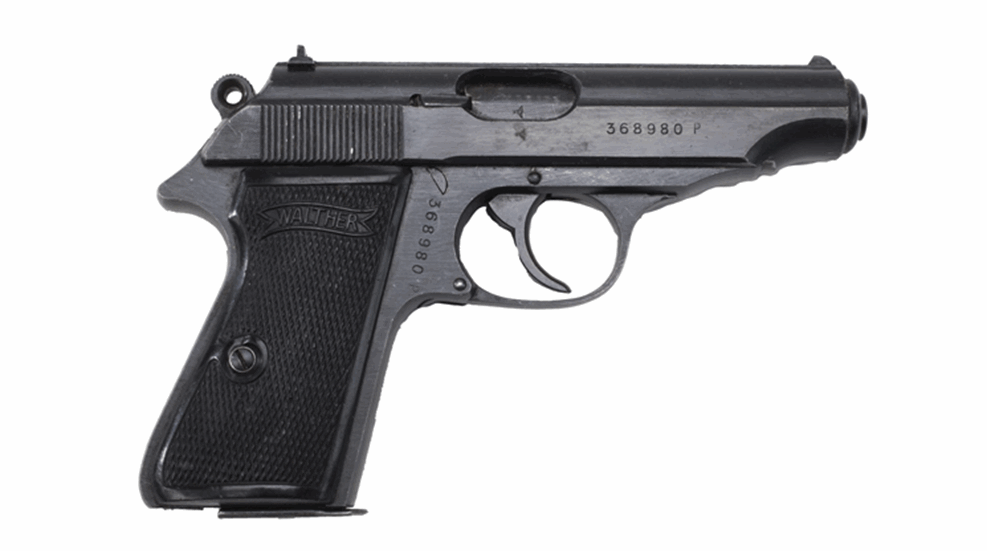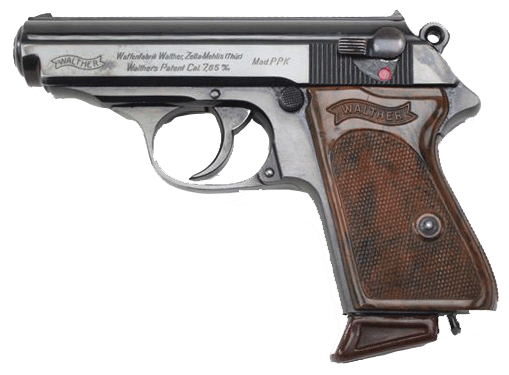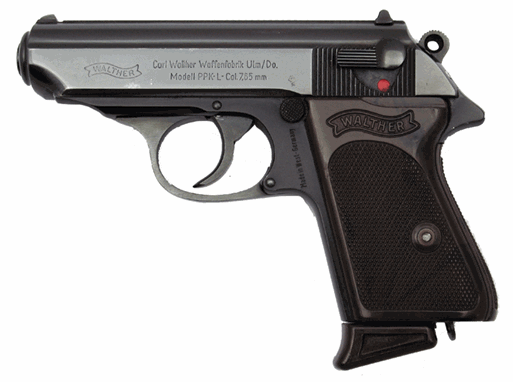
NRA Museums image.
Carl Walther (November 22, 1858 — July 9, 1915) came from a gunmaking family. His father, August Theodor Albert Walther, ran a small brass and iron foundry, while his mother, Rosalie Wilhelmine Amalie Pistor, came from a longtime gunsmith family. Carl worked as a rifle maker early on in his career, opening his own shop in 1886 in Zella-Mehlis, Thuringia. Here the young gunsmith built hunting and target rifles on Martini and Aydt falling-block receivers. During the last decade of the 19th century, the concept of self-loading firearms caught fire, and Carl, along with his son Fritz, became enamored with the notion of a semi-automatic pistol.
In 1908, Walther brought out its first semi-automatic or self-loading pistol, the Deutche Selbstlade Pistole Walther, Modell 1910, Kaliber 6,35, later to be called the Model 1. It featured an open-top slide, an enclosed hammer and was chambered in 6.35x15 Browning (.25 ACP). Its design was straight blowback, and it was made until 1914. Successive models (2 through 9) were brought out, each having more refinements than its predecessor and each garnering varied support of German military officers.
Carl died in 1915, but Fritz continued the pursuit of semi-automatic pistols. At the time, double-action revolvers were very popular throughout the law enforcement world. Cited for their inherent safety and speed of deployment, Walther set about incorporating a double-action trigger mechanism in a semi-automatic pistol. Because the slide reciprocates during the firing of a semi-automatic pistol, thus cocking the piece and making it ready for a follow-up shot, Walther had to meld a double-action lockwork with single-action capability as well. In 1929, Walther succeeded in producing a workable single-/double-action (DA/SA) fire-control mechanism, bringing out the Model PP (Polizeipistole or police pistol).
The PP featured an exposed hammer, fixed barrel, a single-column, eight-round magazine and retained the blowback operation of its predecessors. Sights consist of a fixed blade at the front of the slide with a rear notch dovetailed in the rear of the slide. Its target audience of police personnel—especially in Europe—eagerly embraced this forward-looking design, and it was in continuous service until about 1992, when the desire for more powerful and substantial pistols than the 7.65x17 Browning (.32 ACP) overshadowed it.
As part of the first DA/SA lockwork, Walther introduced the first safety hammer drop, a feature duplicated today on virtually every DA/SA pistol manufactured. The safety lever, located on the left rear portion of the slide, has two positions: “safe” with the lever pointed down and “fire” with the lever pointed forward. When the pistol is fully loaded—a full magazine and another round in the chamber—and the hammer is cocked, pushing the safety lever downward releases the hammer, but a spindle located on the safety internally blocks the hammer from hitting the firing pin. Moving the safety lever forward to the “fire” position frees the trigger to move forward. In this manner, it is safe to carry the pistol loaded with a round in the chamber and the hammer down. When the pistol is needed, one simply presents it to the target and pulls through a long and relatively heavy trigger pull to fire the pistol. After the first shot, the hammer is cocked and the trigger is toward the rear of the trigger guard, ready for a subsequent single-action shot.
With its 3.86" barrel, an overall length of 6.69" and a weight of just 23 1/2 oz., the PP was and remains a very handy and easy-to-carry pistol. During World War II, Nazi police and Wehrmacht officers proudly carried the PP. It proved to be a very reliable design, though a bit lacking in stopping power.
Walther PPK (NRA Museums image).
Because of its popularity, the PP was chambered in other calibers such as .22 LR, 9x17 mm Short (.380 ACP), 6.35x15 mm Browning (.25 ACP) and 9x18 mm Ultra (PP-Super). Variations were numerous, the most popular and earliest being the PPK, a scaled down model with a .6" shorter barrel and a shorter and thinner grip frame that necessitated one less round in the magazine and featured two-piece wraparound grip panels enclosing the backstrap. During the 1960s, Walther introduced a PPK-L that featured a frame made from aluminum that trimmed nearly half a pound from the PPK’s weight. A PPK/S model debuted after the Gun Control Act of 1968 prohibited the importation of the PPK because of dimensional issues. The PPK/S combined the PP’s frame with the PPK’s slide for a slightly larger and heavier compact pistol. Eventually, Walther got around the import restriction by licensing the manufacture of a stainless steel PPK to Walther Arms in Fort Smith, Ark.
Walther PPK-L (Wikipedia image)
Heeding the call for a more powerful chambering, Walther made the PP Super starting in 1972. The PP Super was chambered for the 9x18 mm Ultra, a cartridge resurrected from the 1930s that is a little less powerful than the 9 mm Parabellum. This model was discontinued in 1979.
After World War II, Fritz escaped the Soviets in East Germany, eventually setting up shop in Ulm, West Germany. In order to generate enough capital to build a new plant, he licensed PP and PPK manufacturing rights to Manufacture de Machines du Haut-Rhin, in Mulhouse, France, in 1952. Known by the name Manurhin, these pistols manufactured during the 1950s and ’60s are said to be identical in quality and reliability as the pre-war Walthers. The contract with Manurhin expired in 1986.
More than 5 million copies of the PP and PPK pistol have been manufactured, and these pistols are still being made. Any gun that has been around as long as this will undoubtedly have some baggage—some good, some bad. It is said that Adolph Hitler used a Walther PP-series pistol to kill Eva Braun and himself in 1945. The PPK was the pistol of choice for the Sean Connery rendition of James Bond in the movie, “Dr. No.” And the PP and PPK had to take on some bad press prior to the 1968 Gun Control act when the obfuscative term “Saturday Night Special” was coined. Though lacking a bit in power, the PP and PPK pistols are a seminal point in handgun design, giving us the now extremely popular DA/SA fire-control system.
Additional Reading:
Walther. Carl Walther.
Video: Walther PPK/S .22LR
Walther PPK/S .22 Long Rifle Review




































